Thomas is retired from the William H. Miner Agricultural Research Institute and is the president of Oak Point Agronomics Ltd., Hammond, N.Y. Mahanna is with Pioneer, a DuPont Business, and is an adjunct professor at Iowa State University.

Alfalfa and grass differ considerably in their harvest requirements.
Alfalfa has tap roots that store nutrients needed for the next crop.
Grasses regrow from the cut stems
Recently, there's been increased interest in cool-season forage grasses and for several good reasons: While alfalfa may be the "queen of forage crops," not all soils are suited for alfalfa. Less-than-perfect drainage can limit alfalfa's potential, while some fields are so stony or hilly that a long-lived, sod-forming crop is preferred.
Well-managed grasses fit both these situations: We know of grass fields well over 20 years old that are still very productive. And annual input costs for grasses (primarily fertilizer and pest control) are somewhat less than for alfalfa: The queen of forage crops has expensive tastes!
Species is important
Grass species differ in their tolerance to soil drainage and seasonal growing conditions. Reed canarygrass will tolerate very wet soils, while orchardgrass will not. Orchardgrass and tall fescue will produce well under typical summer growing conditions, while timothy will become somewhat dormant when the weather turns warm and dry.
Forage quality also differs among grass species: Cornell University research reported somewhat higher forage quality for tall fescue versus reed canarygrass when both were harvested at the boot stage. Therefore, it's important to select a grass species based on field conditions and on the intended use.
There can be large differences in maturity within the species. For instance, early maturity varieties of timothy and orchardgrass head out at least 10 days earlier than late maturity varieties of the same species. There's somewhat less varietal difference in the heading dates of reed canarygrass, tall fescue, and bromegrass.
Within a species, there's little difference in forage quality when the varieties are harvested at the same stage of maturity. However, there are significant differences in varietal yield within a species, so variety selection is important. It's sometimes difficult to find performance data on grass varieties, but both Cornell University and Pennsylvania State University maintain an extensive grass testing program, including yield and quality data for both new and established varieties of the most common cool-season grass species.
Different harvest focus
Alfalfa and grass differ considerably in their harvest requirements. Alfalfa has tap roots that store nutrients needed for the next crop. Alfalfa doesn't regrow from the cut stems but from crown buds. Therefore, while alfalfa cutting height affects both yield and quality (yield more than quality), it has little impact on nutrient availability.
Grasses, on the other hand, don't have tap roots and regrow from the cut stems. This is the case whether it's your lawn or a field of orchardgrass. Nutrients for the following crop are stored in the bottom few inches of the plants, so cutting height can impact both regrowth and stand life.
The trend toward disc mowers (versus sicklebar mowers) has resulted in lower stubble heights because disc knives are less apt to be damaged from scalping the soil surface or hitting rocks. Not long after disc mowers became popular, farmers in Pennsylvania and Maryland began encountering reduced orchardgrass yields and sometimes the loss of stands. Most of these problems could be attributed to reduced stubble height: The grass simply didn't have enough nutrients in the remaining stubble for normal regrowth.
While it's OK to mow alfalfa to a 2-inch stubble height - taking field topography, rocks, and so forth into consideration - many agronomists now recommend a 4-inch stubble height for cool-season forage grasses. This may be especially important with certain species and during the seeding year. In a greenhouse trial at Miner Institute, we completely killed seeding year reed canarygrass when we harvested it at a 2-inch stubble height, while the same variety cut at a 4-inch stubble height regrew to 16 inches in three weeks.
Nitrogen boosts yields
Grasses are able to find soil potassium very efficiently. In fact, many times grass forage will contain a normal concentration of potassium (about 2.5 percent K) at soil test potassium levels that are too low to even sustain a stand of alfalfa.
However, nitrogen, applied as manure or fertilizer, is absolutely essential for both yield and quality. Compared to alfalfa, a higher proportion of total annual grass yield is in the first cutting, so both the rate and timing of spring-applied nitrogen are critical. Nitrogen rates depend on field conditions and past manuring practices, but 100 pounds per acre of actual N (equivalent to about 220 pounds of urea or 300 pounds of 32 percent UAN/acre) applied soon after growth starts in the spring is a commonly recommended rate for first-cut grass.
Nitrogen will raise both yield and crude protein; compared to no fertilizer, the proper rate of nitrogen can double yields and enhance crude protein levels by about half. Other nutrients can usually be supplied by summer and fall manure applications; at Miner Institute, we haven't applied any fertilizer P or K to grass fields in over 20 years.
For more on grass:
Cornell
http://css.cals.cornell.edu/cals/css/extension/upload/2010_NYForageSummary_Total-2.pdf
Penn State
http://cropsoil.psu.edu/extension/forage-variety/pubs/2010-forage-trials-report.pdf
Click here to return to the Crops & Forages E-Sources
110410_268

Alfalfa has tap roots that store nutrients needed for the next crop.
Grasses regrow from the cut stems
Recently, there's been increased interest in cool-season forage grasses and for several good reasons: While alfalfa may be the "queen of forage crops," not all soils are suited for alfalfa. Less-than-perfect drainage can limit alfalfa's potential, while some fields are so stony or hilly that a long-lived, sod-forming crop is preferred.
Well-managed grasses fit both these situations: We know of grass fields well over 20 years old that are still very productive. And annual input costs for grasses (primarily fertilizer and pest control) are somewhat less than for alfalfa: The queen of forage crops has expensive tastes!
Species is important
Grass species differ in their tolerance to soil drainage and seasonal growing conditions. Reed canarygrass will tolerate very wet soils, while orchardgrass will not. Orchardgrass and tall fescue will produce well under typical summer growing conditions, while timothy will become somewhat dormant when the weather turns warm and dry.
Forage quality also differs among grass species: Cornell University research reported somewhat higher forage quality for tall fescue versus reed canarygrass when both were harvested at the boot stage. Therefore, it's important to select a grass species based on field conditions and on the intended use.
There can be large differences in maturity within the species. For instance, early maturity varieties of timothy and orchardgrass head out at least 10 days earlier than late maturity varieties of the same species. There's somewhat less varietal difference in the heading dates of reed canarygrass, tall fescue, and bromegrass.
Within a species, there's little difference in forage quality when the varieties are harvested at the same stage of maturity. However, there are significant differences in varietal yield within a species, so variety selection is important. It's sometimes difficult to find performance data on grass varieties, but both Cornell University and Pennsylvania State University maintain an extensive grass testing program, including yield and quality data for both new and established varieties of the most common cool-season grass species.
Different harvest focus
Alfalfa and grass differ considerably in their harvest requirements. Alfalfa has tap roots that store nutrients needed for the next crop. Alfalfa doesn't regrow from the cut stems but from crown buds. Therefore, while alfalfa cutting height affects both yield and quality (yield more than quality), it has little impact on nutrient availability.
Grasses, on the other hand, don't have tap roots and regrow from the cut stems. This is the case whether it's your lawn or a field of orchardgrass. Nutrients for the following crop are stored in the bottom few inches of the plants, so cutting height can impact both regrowth and stand life.
The trend toward disc mowers (versus sicklebar mowers) has resulted in lower stubble heights because disc knives are less apt to be damaged from scalping the soil surface or hitting rocks. Not long after disc mowers became popular, farmers in Pennsylvania and Maryland began encountering reduced orchardgrass yields and sometimes the loss of stands. Most of these problems could be attributed to reduced stubble height: The grass simply didn't have enough nutrients in the remaining stubble for normal regrowth.
While it's OK to mow alfalfa to a 2-inch stubble height - taking field topography, rocks, and so forth into consideration - many agronomists now recommend a 4-inch stubble height for cool-season forage grasses. This may be especially important with certain species and during the seeding year. In a greenhouse trial at Miner Institute, we completely killed seeding year reed canarygrass when we harvested it at a 2-inch stubble height, while the same variety cut at a 4-inch stubble height regrew to 16 inches in three weeks.
Nitrogen boosts yields
Grasses are able to find soil potassium very efficiently. In fact, many times grass forage will contain a normal concentration of potassium (about 2.5 percent K) at soil test potassium levels that are too low to even sustain a stand of alfalfa.
However, nitrogen, applied as manure or fertilizer, is absolutely essential for both yield and quality. Compared to alfalfa, a higher proportion of total annual grass yield is in the first cutting, so both the rate and timing of spring-applied nitrogen are critical. Nitrogen rates depend on field conditions and past manuring practices, but 100 pounds per acre of actual N (equivalent to about 220 pounds of urea or 300 pounds of 32 percent UAN/acre) applied soon after growth starts in the spring is a commonly recommended rate for first-cut grass.
Nitrogen will raise both yield and crude protein; compared to no fertilizer, the proper rate of nitrogen can double yields and enhance crude protein levels by about half. Other nutrients can usually be supplied by summer and fall manure applications; at Miner Institute, we haven't applied any fertilizer P or K to grass fields in over 20 years.
For more on grass:
Cornell
http://css.cals.cornell.edu/cals/css/extension/upload/2010_NYForageSummary_Total-2.pdf
Penn State
http://cropsoil.psu.edu/extension/forage-variety/pubs/2010-forage-trials-report.pdf
110410_268











